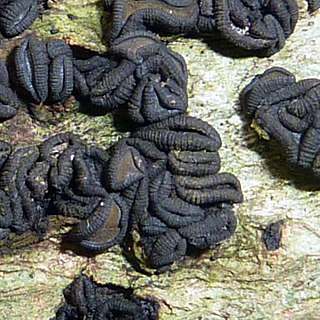
The Portulacaceae are a family of flowering plants, comprising 115 species in a single genus Portulaca. Formerly some 20 genera with about 500 species, were placed there, but it is now restricted to encompass only one genus, the other genera being placed elsewhere. The family has been recognised by most taxonomists, and is also known as the purslane family. It has a cosmopolitan distribution, with the highest diversity in semiarid regions of the Southern Hemisphere in Africa, Australia, and South America, but with a few species also extending north into Arctic regions. The family is very similar to the Caryophyllaceae, differing in the calyx, which has only two sepals.
Spegazziniophytum is a plant genus of the family Euphorbiaceae first described as a genus in 2001. It contains only one known species, Spegazziniophytum patagonicum, endemic to Argentina.
Parodiodendron is a monotypic plant genus under the family Picrodendraceae, described as a genus in 1969. The sole species is Parodiodendron marginivillosum(Speg.) Hunz..

Nassauvia is a genus of flowering plants in the tribe Nassauvieae within the family Asteraceae. It is native to Argentina, Bolivia, Chile and the Falkland Islands.
Seynesia is a genus of fungi in the family Cainiaceae.
Verruculina is a monotypic genus of fungi in the family Didymosphaeriaceae.

Oudemansiella is a genus of fungi in the family Physalacriaceae. The genus contains about 15 species that are widely distributed in tropical and temperate regions. Yang and colleagues revised the genus in a 2009 publication, describing several new species and several varieties. They classified species in the genus into four sections based on the structure of the cap cuticle: Oudemansiella, Mucidula, Dactylosporina, and Radicatae.
Ameghinoa is a genus of flowering plants in the family Asteraceae, described in 1897 by Carlo Luigi Spegazzini.
Graphium is a genus of fungi in the family Microascaceae. Many species are known as plant pathogens. Graphium belongs to the group hyphomycetes and has about 20 species. They are found in soil, plant debris, woody substrate, manure, and polluted water. The sporulating structures of Graphium form synnema, which are a gathering of conidiophores into a sort of flower bouquet. Graphium spp. are recognized by their distinctive, erect, black synnemata, each bearing a single, terminal, ball of one-celled, hyaline conidia produced from annellides.

Carlo Luigi Spegazzini, in Spanish Carlos Luis Spegazzini, was an Italian-born Argentinian botanist and mycologist.

Rhytidhysteron is a genus of fungi in the family Patellariaceae. It has 21 species.

The Didymellaceae are a family of fungi in the order Pleosporales. The have a world-wide distribution.

Benthamiella is a genus of plants in the family Solanaceae, native to Patagonia in southern South America. Its species have been described as "attractive, small, cushion plants".
Burgoa is a genus of fungi belonging to the family Cantharellaceae.
Delpinophytum is a monotypic genus of flowering plants belonging to the family Brassicaceae, with one species, Delpinophytum patagonicum(Speg.) Speg.
Lecanophora is a genus of flowering plants belonging to the family Malvaceae.
Philippiella is a monotypic genus of flowering plants belonging to the family Thymelaeaceae. It just contains one species, Philippiella patagonicaSpeg.
Asterostomella is a genus of fungi in the Asterinaceae family. The relationship of this taxon to other taxa within the class is unknown, and it has not yet been placed with certainty into any order. They are leaf parasites. Such as Asterostomella miliusaeA.K. Singh, Kamal & Shiv K. Singh (1982) is found on Miliusa tomentosa(Roxb.) Finet & Gagnep. plants in India as a type of 'black mildew'.






